FREESKY Blogs
Stay updated with the latest news, tips, and insights on e-bikes, technology, and sustainable riding through the FREESKY blog.
There's no item in your cart.
You May Also Like
You're Saving €0,00
Shipping, taxes, and discount codes calculated at checkout.All Topics

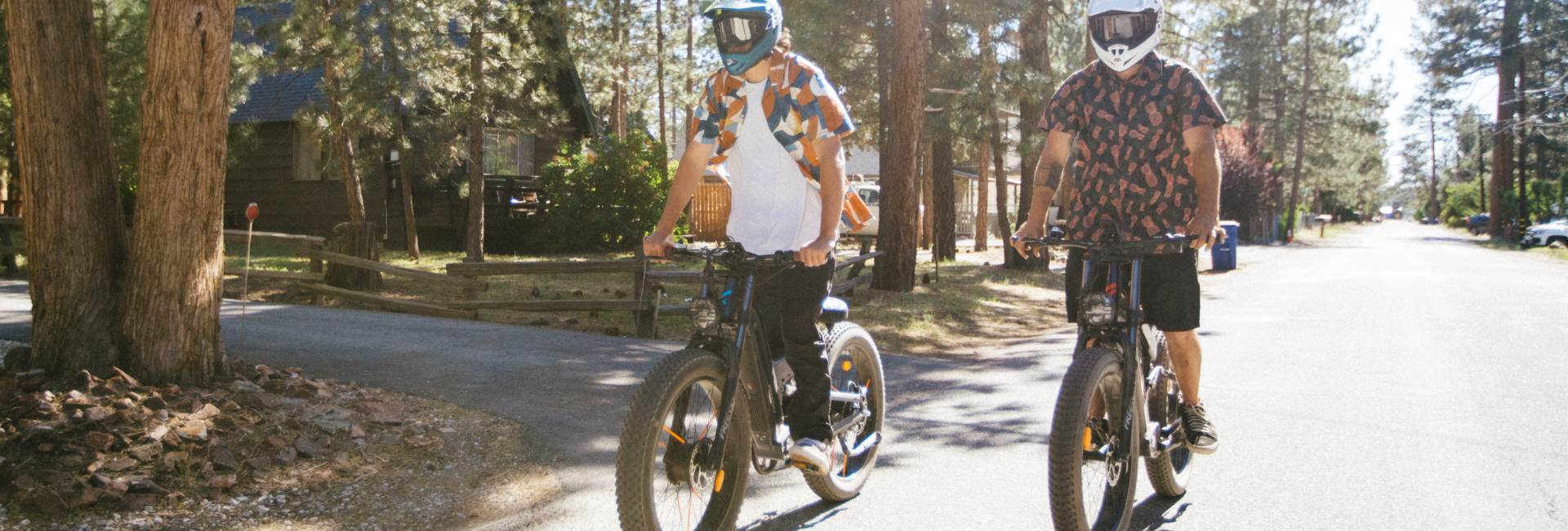
How Far Can an Electric Bike Go?
Jul 18, 2025 09:00
Understanding Electric Bike Range Electric bikes have revolutionized personal mobility across Europe. From daily commutes in busy cities to long countryside tours, e-bikes provide freedom, comfort, and extended reach. But one common question remains:How far can an electric bike go on a single charge? While many standard e-bikes offer a range between 32 km and 160 km, Freesky’s lineup significantly outperforms the average, delivering real-world ranges from 96 km to 257 km. With high-capacity batteries and precision-engineered motors, Freesky e-bikes are built to take you farther—no matter the road ahead. What Influences an E-Bike’s Range? 1. Battery Capacity – The Foundation of Distance Battery capacity, measured in watt-hours (Wh), plays a key role in how far your e-bike can travel per charge. Freesky models are equipped with industry-leading battery systems ranging from 1104Wh to 1968Wh, using reliable, high-quality lithium cells. Examples include: - Alaska Pro: Dual 48V 41Ah batteries — up to 257 km range - Warrior Pro: 48V 30Ah Samsung battery — up to 152 km - Ranger: 48V 23Ah battery — up to 152 km These extended ranges allow for long-distance rides and multi-day journeys with less frequent charging—ideal for touring, commuting, or delivery applications. 2. Motor Efficiency and Torque Output According to EU regulations, road-legal electric bikes are limited to 250W continuous motor output and must assist only up to 25 km/h. However, torque (measured in Newton-metres, or Nm) is the critical factor for real-world performance, especially on hills or under load. - Warrior Pro: Dual motors delivering up to 200Nm of torque—exceptional for steep climbs and demanding off-road use - Ranger: Dual-motor system with 160Nm of torque—balanced for urban and all-terrain environments High-torque systems allow for smoother acceleration, improved hill climbing, and efficient battery usage—perfect for Europe’s mixed topography. 3. Terrain, Load, and Riding Style Beyond motor and battery specs, several riding conditions also affect total range: - Terrain: Flat pavement optimizes range, while hills and uneven surfaces increase energy consumption - Payload: More weight (rider or cargo) means more power required to maintain speed - Assist Mode: Riding in high pedal-assist levels drains battery faster; eco modes and consistent pacing preserve charge How to Maximise Your E-Bike’s Range To extend the life of each charge, follow these tips: - Use lower pedal assist levels whenever practical - Maintain consistent speeds and avoid unnecessary braking or acceleration - Ensure proper tyre inflation for reduced rolling resistance - Store and charge batteries in a cool, dry place, and avoid complete discharges - Travel light by minimizing extra gear or cargo Implementing these habits can extend your riding distance and preserve battery health long-term. Best Freesky E-Bikes for Long-Distance Riding in Europe Freesky’s EU collection focuses on three high-performance models designed for superior range and real-world practicality: Warrior Pro - Battery: 48V 30Ah Samsung battery - Motor: Dual motors with up to 200Nm torque - Range: 96–152 km - Suspension: Full suspension - Best For: All-terrain riders who need strong hill climbing ability and durability on rough surfaces. Excellent for countryside commutes and outdoor adventuring. 👉 Shop Now Alaska Pro - Battery: Dual 48V 41Ah battery system (total 1968Wh) - Range: 144–257 km - Suspension: Full suspension - Best For: Riders focused on long-distance journeys, heavy loads, and endurance riding. Ideal for tourers and those requiring all-day power. 👉 Shop Now Ranger - Battery: 48V 23Ah - Motor: Dual motors with 160Nm torque - Range: 96–152 km - Best For: Versatile use across cities and rural roads. Perfect for commuters who want extra support on steeper gradients or mixed terrain. 👉 Shop Now Conclusion Battery capacity, terrain, riding habits, and torque all impact how far your electric bike can take you. Freesky e-bikes are engineered to maximize all of these variables, consistently outperforming average range figures found in the EU e-bike market. Whether you're cycling to work, exploring new routes, or tackling weekend adventures, Freesky gives you the reliability and power to ride farther with confidence. With ranges of up to 257 km, your journey doesn't stop where the road ends. Frequently Asked Questions 1. What is the real-world range of a Freesky e-bike?Freesky models in the EU offer 96 km to 257 km depending on battery size, terrain, and riding conditions. 2. What affects the range of an e-bike?Key factors include battery capacity, terrain type, rider weight, assist level, and motor torque. 3. Which model has the longest range?The Alaska Pro has the highest capacity, capable of up to 257 km per charge. 4. Are Freesky e-bikes compliant with EU road regulations?Yes. All models are limited to 250W continuous power and a maximum assisted speed of 25 km/h, fully complying with EU e-bike standards. 5. Can Freesky e-bikes handle hills and rural terrain?Absolutely. With torque ratings up to 200Nm, models like the Warrior Pro are built for demanding environments, including steep climbs and rough paths.
Read More
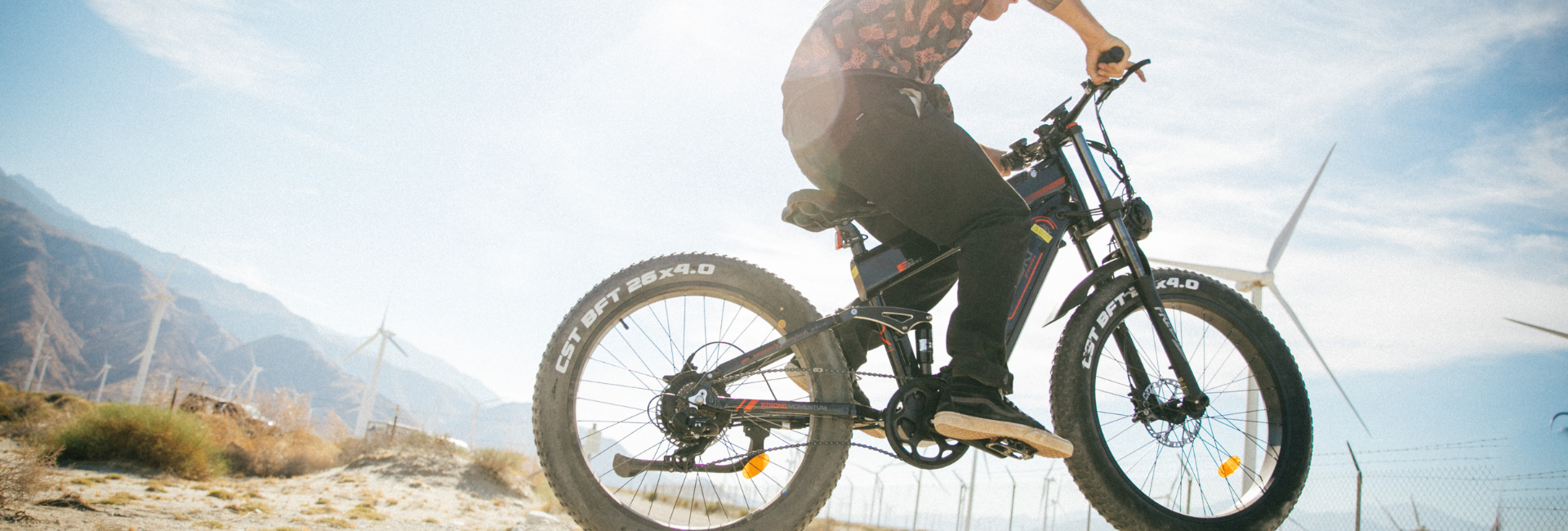
Full-Suspension Electric Mountain Bikes: Elevate Your Off-Road Experience
Jun 20, 2025 09:00
Across Europe, from the pine forests of the Black Forest to the rugged terrain of the Pyrenees and the alpine trails of Slovenia, full-suspension electric mountain bikes (e-MTBs) are transforming the way riders explore the great outdoors. These bikes combine electric assistance with advanced suspension systems, delivering comfort, traction, and power—even in the most demanding landscapes. 🚵 What Is a Full-Suspension e-MTB? A full-suspension e-MTB is an electric mountain bike designed with both front fork suspension and a rear shock absorber, which together reduce the impact of rocky, uneven ground. Combined with a pedal-assist electric motor and high-capacity battery, this setup allows for smoother riding over long distances, even on mountainous terrain or technical trails. Whether you're climbing steep fire roads in the Dolomites or descending singletrack in the Ardennes, a full-suspension e-bike provides the versatility, power, and comfort you need for every kilometre. Why Full Suspension Matters in Europe European trails can be unpredictable—wet forest floors, gravel alpine descents, exposed roots, and technical rock gardens are all part of the experience. A full-suspension e-MTB helps you: Absorb trail shocks to reduce fatigue on long rides Maintain control through fast descents and tight corners Improve grip on uneven or loose terrain Navigate alpine climbs with electric assistance and less effort Key Benefits: ✅ Superior comfort over rough terrain ✅ Better handling on technical climbs and descents ✅ Electric assistance extends your riding range ✅ Ideal for extended exploration of nature reserves and mountain parks Freesky’s Approach to Full-Suspension e-MTBs Freesky bikes are engineered to handle the challenges of Europe’s varied terrain. We combine robust suspension systems with reliable battery technology to ensure riders experience consistent, safe, and powerful performance—whether they’re riding across Scandinavian woodland or Southern Europe’s sun-baked trails. 🔧 Engineering That Performs Hydraulic front and rear suspension for better shock absorption Sturdy aluminium alloy frames for strength without unnecessary weight Grippy, puncture-resistant tyres designed for varied European surfaces ⚡ Certified Power Systems Warrior Pro: 48V 30Ah battery with Samsung cells Alaska Pro: 48V 41Ah high-capacity Freesky battery All Freesky e-MTB batteries are UL 2271- and CE-certified, ensuring full compliance with EU safety standards and transport regulations. 🚴 Designed for European Trails Warrior Pro Agile and responsive, ideal for twisty forest trails and hilly terrain found across Central Europe. Alaska Pro Built for distance, with long travel suspension and extended battery range—perfect for full-day adventures in the Alps or across Mediterranean highlands. Ride with Purpose Freesky e-MTBs not only bring the fun back to off-road cycling—they support a cleaner, more sustainable mode of transport. Enjoy the outdoors while lowering your environmental impact. With no fuel, low noise, and reduced emissions, our bikes support eco-conscious travel across Europe’s protected landscapes. Why Choose Freesky in the EU? Feature Rider Advantage Across Europe Dual suspension Comfort and control on unpredictable trails Long-range battery options Confidently explore rural and mountain areas European safety certifications Peace of mind with UL 2271 compliance High-performance motor systems Smooth assist across climbs and descents Responsive support network EU-based post-sale assistance available Take on the Trails—The Smarter Way Whether you're venturing into the Bavarian woods, Catalonian ridges, or the Balkan backcountry, a full-suspension electric mountain bike from Freesky equips you with the power and comfort to go further—confidently. Explore the Warrior Pro and Alaska Pro models and take the first step towards your next off-road journey across Europe.
Read More

How We Test Electric Mountain Bikes: Freesky’s Approach to Real-World Performance
Jun 13, 2025 09:00
Selecting the right electric mountain bike (e-MTB) is about more than technical specifications — it’s about how a bike performs across real-world terrain, in real conditions. At Freesky, we believe in field testing that reflects the true riding environments our customers face — whether that’s navigating Alpine singletrack, forest routes in central Europe, or rocky Mediterranean trails. Our testing methodology has been developed to ensure our e-MTBs deliver dependable performance, intuitive handling, and lasting durability throughout the European riding landscape. 🧑🔬 1. Rider-Led Evaluation Our testing is conducted by a panel of experienced riders who understand the diverse terrain types across Europe — from mountain regions to lowland trail networks. Every bike is tested over several weeks in a variety of environments, with testers rotating bikes and sharing detailed ride feedback. This allows us to build a complete performance profile of each model under consistent and varied conditions, from technical climbs in the Pyrenees to flow trails in Germany’s Black Forest. 📲 2. Interface: Controls, Display & Connectivity Modern e-MTBs depend on seamless interaction between rider and motor system. We evaluate: Control unit layout and responsiveness Display visibility in direct sunlight or low-light conditions Bluetooth app functionality: configuration, updates, diagnostics Charging access and ergonomics Ease of use matters — especially when adjusting support levels during long-distance rides or in variable conditions such as rain or dust. 🧗 3. Climbing Capability Europe’s trail networks demand strong climbing performance — from Alpine ascents to rolling countryside. We evaluate: Motor responsiveness and torque Geometry and rider positioning Traction on loose or steep surfaces Testing includes repeat climbs on varying gradients and terrain types to assess consistency and power delivery in assisted modes. 🚵 4. Downhill Stability and Control Safe, confident descending is essential for e-MTBs. We conduct downhill tests across multiple trail types — from rocky alpine routes to fast-flowing woodland descents — to examine: Frame geometry and balance Suspension absorption and rebound Braking effectiveness and fade resistance Multiple back-to-back test runs allow side-by-side comparisons, providing objective insights into ride control and responsiveness. ⚙️ 5. Power Delivery and Ride Feel All motors may list similar outputs, but their ride feel can vary greatly. We measure: Torque delivery and smoothness Power onset and cutoff timing Support transition between assist levels Governor limit and response at 25 km/h (EU legal limit) We prioritise models with consistent, natural-feeling support that responds quickly to pedal input without abrupt transitions. 🔋 6. Range Testing: Field-Based and Repeatable The range of an e-MTB depends on many variables: terrain, elevation, rider weight, riding mode, and weather. To control for these, we use a standardised test circuit representative of typical European trail environments, including: Steep climbs on mixed gravel and soil Descending routes with minimal motor support Mid-ride pauses to simulate typical rest intervals Each model is tested repeatedly until battery depletion, and data is tracked via GPS and digital display metrics. 🌧️ 7. Durability Testing in Varied European Conditions From springtime mud in northern Europe to summer dust in southern trails, durability is critical. Over extended rides and weather exposure, we assess: Battery housing and water resistance Cable routing and protection Suspension seals and brake component resilience Post-ride cleaning and maintenance checks We aim to replicate conditions riders actually face, ensuring the bike can perform reliably — not only during perfect weather, but also through months of variable use. Freesky’s E-MTBs: Built for the Demands of Europe Freesky’s Warrior Pro and Alaska Pro models undergo this full testing protocol before market launch. Each model is designed to meet the challenges of Europe’s diverse terrain, climate, and ride preferences: Warrior Pro: Equipped with a 48V 30Ah Samsung battery (UL2271 and CE certified), ideal for riders demanding powerful uphill support with high-torque output. Alaska Pro: Features a robust 48V 41Ah battery (UL2271 and CE certified) for long-distance endurance and optimal power efficiency on extended trail routes. Both models are designed to conform with EU safety standards, with a focus on intelligent power distribution, rider comfort, and real-world trail performance. Overview Table: Freesky's EU E-MTB Testing Criteria Category Testing Focus Purpose Controls & Display Visibility, ease of use, app integration Improve usability on the trail and in varying weather Climbing Performance Torque, handling, motor balance Assess capability across European elevation profiles Descending Dynamics Geometry, suspension, braking Ensure downhill safety and rider confidence Power Output Smoothness, timing, support feel Match assist behaviour to rider input and trail style Range Consistency, depletion pattern, terrain variables Provide realistic travel expectations Durability Environmental exposure, material wear, sealing Maximise reliability year-round Engineered for Europe's Riders At Freesky, we don’t just engineer e-MTBs — we test them in the same conditions our riders face. Our goal is to ensure that whether you’re tackling high-altitude routes or relaxed woodland circuits, your Freesky bike responds predictably, powerfully, and with control. We test to build trust — because your ride depends on it.
Read More
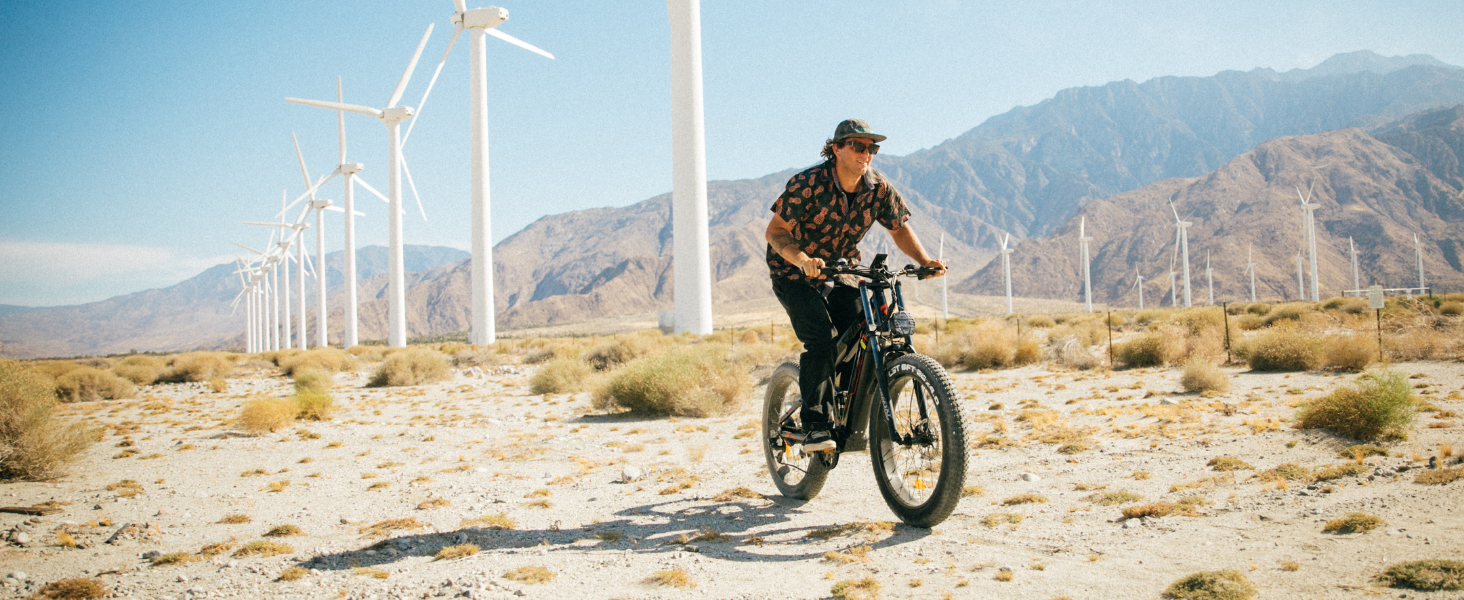
Celebrate World Bicycle Day with FREESKY: Explore Further, Ride Freer
May 30, 2025 09:00
3 June marks World Bicycle Day, a global celebration that recognises cycling as a sustainable, accessible and health-conscious mode of transport. Declared by the United Nations, this day promotes the bicycle as a simple solution to some of the world’s most pressing issues – including climate change, urban congestion, and sedentary lifestyles. At FREESKY, we believe this is the perfect moment to highlight how electric mountain bikes (e-MTBs) empower riders to go farther, ride smarter, and live better. Why Choose an E-Mountain Bike in 2025? Electric mountain bikes are reshaping how people ride – from daily commutes to weekend trail adventures. Whether you’re replacing short car trips, avoiding crowded public transport, or simply looking for a more exhilarating way to explore your surroundings, e-MTBs offer the perfect balance of power, range and performance. FREESKY’s fat-tyre e-bikes are designed to meet the demands of diverse European landscapes – from city streets to gravel paths, forest trails and mountain climbs. Our bikes come equipped with dual batteries, powerful 130 N·m motors, and robust 26×4” fat tyres, providing enhanced traction, comfort, and range. Spotlight: Warrior Pro & Alaska Pro Among our most popular EU models are the Warrior Pro and Alaska Pro – e-MTBs built for riders who demand more. Why Riders Love the Warrior Pro: Dual motor system for unmatched torque and acceleration Four-piston hydraulic disc brakes for precise, powerful stopping in all weather 26×4” all-terrain tyres that glide over sand, snow, mud and gravel Full suspension frame to absorb shock and improve off-road control Why the Alaska Pro Stands Out: Extended range of up to 257 km thanks to dual battery integration Fat tyres for superior grip and a smoother ride than traditional narrow-tyre MTBs Comfort-focused design, ideal for longer rides with mixed terrain Cargo-ready frame, now with a complimentary Rear Rack Package valued at €120 Both models exemplify FREESKY’s commitment to quality, durability, and rider-centric design. FREESKY Sizing and Comfort Thanks to their oversized geometry and 26×4” tyres, FREESKY e-MTBs provide a more upright riding position, improved balance, and better vibration absorption compared to conventional mountain bikes. This is especially important for riders new to e-cycling or returning after a long break. Unlike traditional hardtail MTBs with narrow tyres and aggressive geometry, FREESKY’s frames are tuned for comfort without compromising on capability. Not sure about fit? Our frame size guide and support team are here to help you make the right choice. Limited-Time World Bicycle Day Offer – EU Exclusive To celebrate World Bicycle Day, we’re offering €60 off all FREESKY e-MTBs across Europe – automatically applied at checkout. And it gets even better: when you choose the Warrior Pro or Alaska Pro, you’ll receive a free Rear Rack Package valued at €120, perfect for carrying daily essentials, shopping, or bikepacking gear. 👉 [Shop FREESKY electric Mountain Bikes Now] Ride smarter. Ride further. Ride FREESKY.This World Bicycle Day, take the opportunity to invest in an electric mountain bike that matches your lifestyle – and enjoy savings and performance that go the distance.
Read More
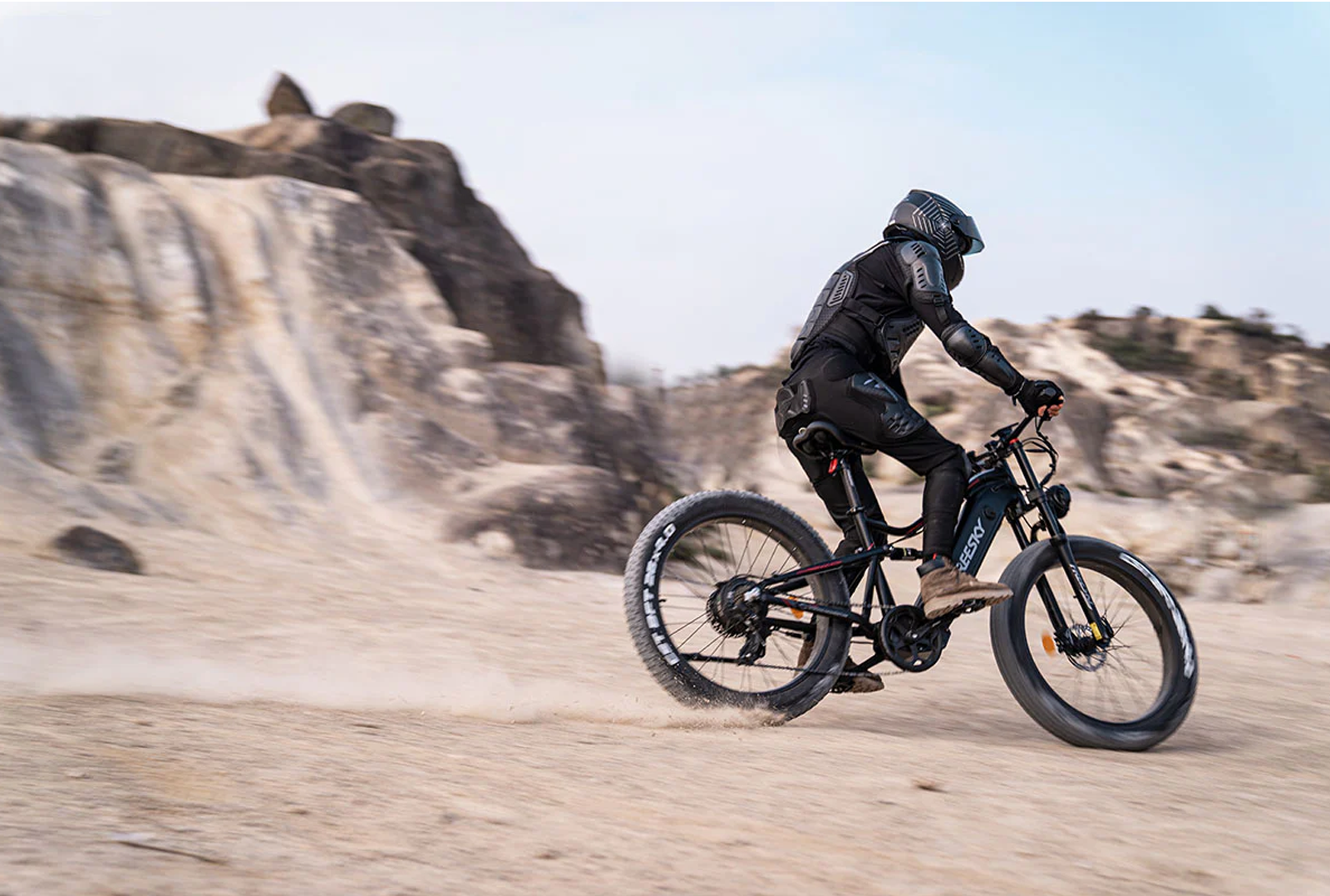
Are Full Suspension Bikes Harder to Pedal?
Mar 21, 2025 04:38
The question of whether full suspension bikes are harder to pedal than their hardtail counterparts is often debated among cyclists, especially those who are considering upgrading their bicycles or making a switch from one type to another. The answer to this question is not straightforward as it involves several factors that can influence the pedaling effort required on a full suspension bike. In this article, we will explore the factors that may affect the pedaling difficulty on full suspension bikes and compare them with hardtail bikes to provide a comprehensive understanding of the issue. First and foremost, it's important to understand the basic differences between full suspension and hardtail bikes. Full suspension bikes feature a suspension system at both the front and rear, designed to absorb impacts and vibrations from the trail, providing a smoother ride. On the other hand, hardtail bikes have a rigid frame, with only the front fork usually equipped with suspension. This fundamental difference in design impacts the pedaling characteristics of each bike type. One of the main concerns about full suspension bikes is the added weight of the suspension system. This additional weight can indeed make pedaling slightly more challenging, especially when climbing steep hills or accelerating from a standstill. The heavier bike requires more effort to move, and the suspension components themselves can introduce some drag due to their internal friction. However, it's worth noting that modern full suspension bikes have made significant advancements in weight reduction and efficiency, minimizing this impact. Another factor that can affect pedaling difficulty on full suspension bikes is the suspension's adjustment and settings. If the suspension is set too soft, it can bob excessively when pedaling, reducing efficiency and causing the rider to expend more energy. Conversely, if the suspension is set too stiff, it may not provide the desired shock absorption, leading to a less comfortable ride but not necessarily making pedaling harder. Finding the right balance in suspension settings is crucial to optimize both comfort and pedaling efficiency. In addition to weight and suspension settings, the geometry of full suspension bikes can also play a role in pedaling difficulty. Full suspension bikes often have a slacker head angle and a longer wheelbase to accommodate the suspension's movement. This geometry can affect the bike's handling and responsiveness, which in turn can influence pedaling feel. However, modern full suspension bikes are designed to minimize these effects and provide a balanced ride that is both comfortable and efficient. On the other hand, hardtail bikes offer a more direct and responsive ride due to their rigid frame. The lack of rear suspension means that the power from the rider's legs is transferred more efficiently to the rear wheel, potentially making pedaling feel easier. Hardtail bikes are often lighter, which can further enhance pedaling performance. However, the lack of shock absorption can make riding on rough terrain less comfortable, potentially leading to fatigue over longer rides. It's worth mentioning that the difficulty of pedaling a full suspension bike can also be influenced by the rider's technique and fitness level. Riders who are used to hardtail bikes may need to adjust their pedaling style to account for the different characteristics of full suspension bikes. Additionally, a fitter and stronger rider may find it easier to overcome the additional challenges posed by a heavier bike or more complex suspension system. In conclusion, the question of whether full suspension bikes are harder to pedal is not a straightforward yes or no answer. The difficulty of pedaling a full suspension bike depends on a variety of factors, including the bike's weight, suspension settings, geometry, as well as the rider's technique and fitness level. While full suspension bikes may require slightly more effort to pedal due to their added weight and complex suspension system, they offer superior comfort and shock absorption on rough terrain, making them a worthwhile choice for many riders. Riders should consider their personal preferences, riding style, and the type of terrain they ride on when making a decision between a full suspension bike and a hardtail. With the right setup and technique, both types of bikes can provide an enjoyable and efficient riding experience.
Read More

Keep Your eBike Battery Healthy This Winter: Essential Tips
Feb 17, 2025 11:04
As winter approaches and temperatures drop, electric bike riders face new challenges in keeping their e-bike batteries in top shape. Cold weather can affect the performance and lifespan of your battery, but with the right care and precautions, you can keep it running smoothly through the colder months. Here’s how you can protect your electric bike battery during winter and ensure it stays in optimal condition. Store Your Battery Indoors One of the most important things you can do to protect your battery is to keep it out of the cold when not in use. When the temperature drops below freezing, the performance and range of your battery can be reduced. To avoid this, store the battery indoors at room temperature (around 15°C to 20°C or 59°F to 68°F) when you’re not riding. A heated garage, basement, or even inside your home is ideal. Quick Tip:If you can’t remove your battery, park your bike in a sheltered, warmer area like a garage. Avoid Charging in Extreme Cold Charging your e-bike battery when it’s too cold can damage its cells. Lithium-ion batteries are sensitive to temperature extremes, and charging them in freezing temperatures can result in permanent damage. To protect your battery, allow it to warm up to room temperature before charging. Once it's been indoors for a while, it's safe to plug it in and let it recharge fully. Quick Tip:If you’ve just returned from a cold ride, bring the battery inside and wait for at least 30 minutes before charging. Insulate Your Battery While Riding If you plan to ride in colder weather, it’s important to keep your battery insulated. A cold battery will drain faster, reducing your range significantly. Investing in a battery cover or thermal sleeve can help regulate the battery’s temperature while riding, protecting it from extreme cold and extending its performance. Quick Tip:You can find neoprene or thermal battery covers specifically designed for electric bike batteries. These are relatively inexpensive and offer great protection during winter rides. Limit Your Riding Time Cold weather causes the chemical reactions inside your battery to slow down, which affects its overall performance. During winter, you may notice a reduction in your battery’s range, meaning it won’t last as long as it does in warmer conditions. To avoid over-draining your battery, limit long-distance rides in freezing temperatures and plan shorter trips to conserve energy. Quick Tip:Keep your e-bike in eco or lower power modes to save battery life when riding in colder conditions. Avoid Fully Draining the Battery Lithium-ion batteries are best maintained when they are kept charged between 20% and 80%. Avoid fully depleting your battery in the cold, as it puts additional stress on the cells. If possible, charge your battery regularly after each ride to keep it healthy and ready to go. Quick Tip:During winter, aim to recharge your battery when it reaches around 30% to prevent any risk of over-depletion. Keep Your Battery Dry Winter often brings snow and slushy conditions, so keeping your battery dry is essential. Moisture can cause corrosion on the battery terminals and connections, leading to long-term damage. Always wipe down your battery after rides in wet or snowy weather, and store it in a dry place. You may also want to add waterproof protection to your battery connections and ensure all seals are intact. Quick Tip:Use a silicone cover to protect the battery port from moisture and water damage during winter rides. Be Mindful of Long-Term Storage If you don’t plan on using your e-bike regularly during the winter months, make sure you prepare your battery for long-term storage. Store the battery at around 50% charge and check on it periodically, recharging it slightly if necessary. Storing your battery at 100% or completely drained can negatively affect its lifespan. Quick Tip:Store your battery in a cool, dry place, and avoid leaving it in freezing conditions for extended periods. Monitor Performance Regularly Cold weather can disguise potential issues with your battery, so it’s important to monitor its performance throughout the winter months. Pay attention to any unusual behavior, like a sudden drop in range or slower charging times, which may indicate the cold has affected the battery. Addressing these issues early can prevent long-term damage. Quick Tip:If you notice a dramatic decrease in performance, consider consulting a professional to check the battery’s health. Conclusion Winter doesn’t have to stop you from enjoying your electric bike, but taking extra care of your battery is essential to keep it running smoothly. By following these simple tips, you can extend the lifespan of your battery and ensure it performs well throughout the cold months. Remember, proper storage, insulation, and mindful charging are the keys to protecting your electric bike battery in winter. Stay warm, and ride safe!
Read More
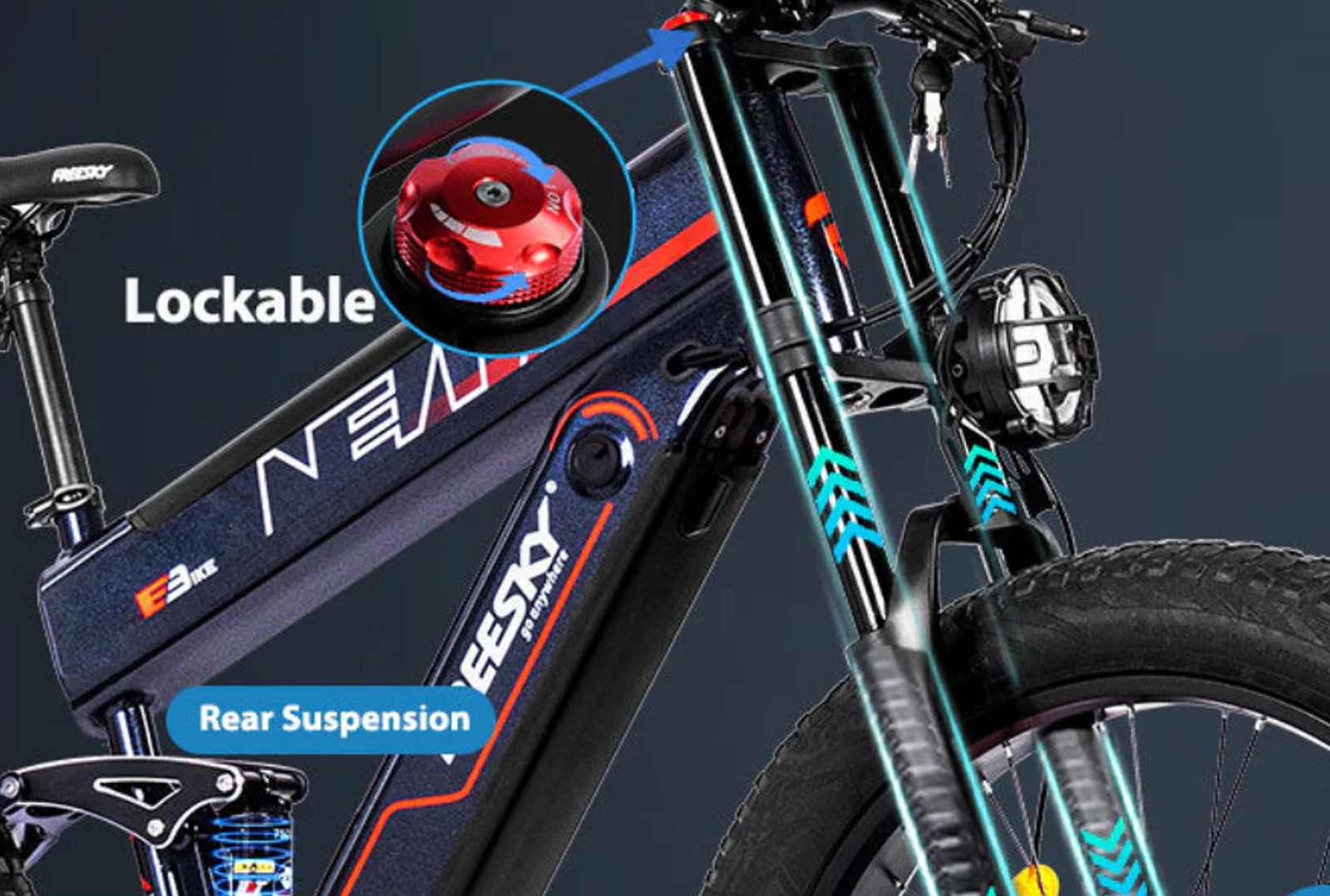
The Utility of Lockable Suspension Forks
Feb 14, 2025 11:07
In the world of bicycles, the fork is a crucial component that plays a pivotal role in the overall performance and handling of the machine. Among the various types of forks available, the lockable suspension fork stands out as a unique and versatile option, offering riders the best of both worlds: the smooth ride of a suspension fork and the stiffness and precision of a rigid fork. This article delves into the question, "What is the use of a lockable suspension fork?" exploring its various benefits and applications. The basic concept of suspension forks: To understand the utility of a lockable suspension fork, it is essential to grasp the basic concept of suspension forks. Suspension forks are designed to absorb the shocks and impacts encountered on uneven terrain, such as bumps, rocks, and roots. They accomplish this by allowing the fork legs to compress and rebound, effectively decoupling the rider and the bike from the harshest vibrations of the trail. This not only enhances comfort but also improves control and reduces fatigue over long rides. Why need lockable suspension fork? However, there are situations where a fully active suspension fork may not be ideal. On smooth roads or during high-speed descents, a rigid fork offers greater precision and steering response. This is where the lockable suspension fork comes into play. By locking out the suspension, riders can enjoy the stiffness and responsiveness of a rigid fork when needed, while still retaining the option to unlock it for more challenging terrain. The lockable suspension fork is a testament to the evolving needs of cyclists and the innovation in bicycle technology. It caters to riders who participate in a diverse range of activities, from commuting to trail riding, and everything in between. For instance, a cyclist commuting to work on smooth city roads may prefer the locked-out setting for a direct and responsive ride. But on the weekend, when exploring off-road trails, the same cyclist can unlock the fork to enjoy a smoother ride over rough terrain. The lockable feature is typically achieved through a mechanical or hydraulic lockout mechanism. These systems allow the rider to quickly and easily switch between locked and unlocked modes, often with the simple twist of a lever or the push of a button. This convenience is crucial, as riders often need to adjust their forks on the fly, depending on the terrain and riding conditions. The use of a lockable suspension fork also extends to the realm of performance racing. In competitive events, every second and every ounce of control counts. Riders can use the lockout feature to maximize their efficiency on smooth sections of the course, while relying on the suspension's damping capabilities to tackle rougher patches. This flexibility allows racers to optimize their bike's setup for different race conditions, potentially giving them a competitive edge. Moreover, the lockable suspension fork is beneficial for riders with specific physical needs or preferences. For instance, riders with back or joint issues may find the locked-out setting more comfortable on certain rides, as it reduces the amount of flex and movement in the front end of the bike. On the other hand, those seeking a more forgiving ride on long-distance tours or enduro races may appreciate the ability to unlock the fork for added comfort. In addition to its practical benefits, the lockable suspension fork also contributes to the overall versatility of a bicycle. With a single bike, riders can tackle a wide range of riding scenarios, from pavement to dirt, without the need for significant modifications or the purchase of multiple bikes. This versatility not only saves money but also simplifies the process of packing and transporting a bike for multi-day trips or races. It's worth noting that while the lockable suspension fork offers significant advantages, it is not without its limitations. The additional complexity and mechanisms of the lockout system can add weight and potentially decrease the fork's overall durability. Riders should carefully consider their needs and riding style before investing in such a fork, to ensure it aligns with their specific requirements. Conclusion In conclusion, the lockable suspension fork is a valuable tool for cyclists seeking the best of both worlds in terms of ride comfort and handling precision. Its ability to adapt to different riding conditions and scenarios makes it a highly versatile and practical addition to any bike. Whether commuting to work, exploring off-road trails, or competing in races, the lockable suspension fork offers riders the freedom and flexibility to enjoy their cycling experience to the fullest. Related Articles: Is a Full Suspension Bike Better Than a Hardtail? The Utility of Lockable Suspension Forks
Read More
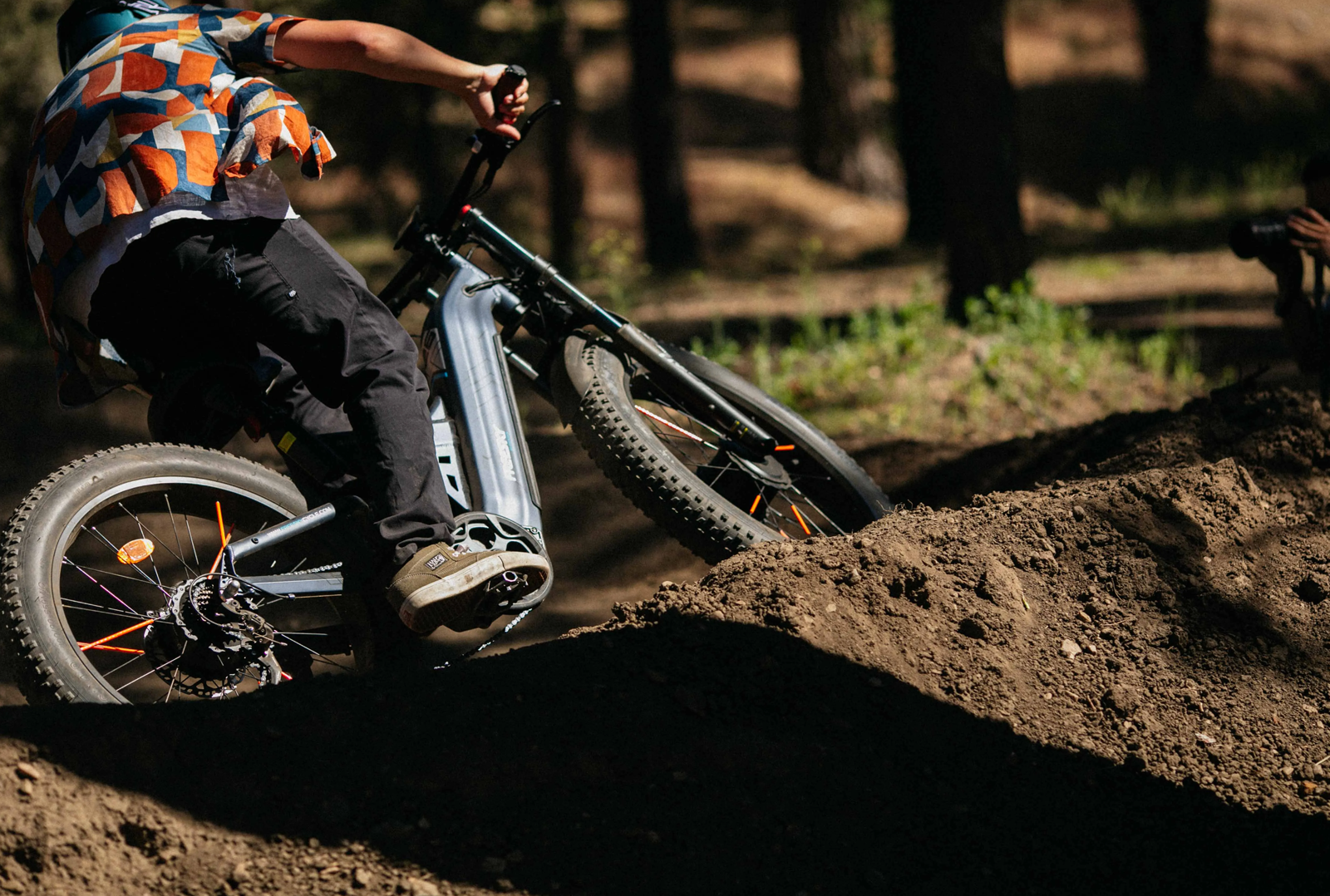
The Truth About Ebike Motor Longevity: What Every Rider Needs to Know
Feb 10, 2025 11:07
When investing in an electric bike, one of the most common questions that come up is: How long will the motor last? Like any machine, the lifespan of an ebike motor depends on several factors, including usage, maintenance, and the type of motor you choose. Whether you own a dual motor ebike for off-road adventures or a simple commuter ebike, understanding motor longevity is key to keeping your ride smooth for years. Factors That Affect Ebike Motor Lifespan Motor Type The type of motor you choose plays a big role in its longevity. Hub motors, which are built into the wheels, are common due to their simplicity and lower maintenance needs. Mid-drive motors are more complex but offer better performance for off-road conditions and steeper climbs. A dual motor ebike with two hub motors provides extra power but may also experience more wear over time due to the increased load on both motors. Maintenance Practices Proper ebike hub motor maintenance is crucial in prolonging the motor's life. Regularly cleaning the motor, ensuring that cables are in good condition, and avoiding exposure to extreme weather conditions all contribute to a longer-lasting motor. Specifically, checking for issues like ebike motor cable replacement when cables show signs of wear can prevent larger, costlier problems down the line. Riding Conditions The terrain and conditions you ride in also impact motor longevity. If you frequently ride uphill or carry heavy loads, your motor works harder, which can lead to wear over time. Additionally, if you notice ebike motor noise under load, this could be an indicator of strain or a need for motor servicing. It’s best to address these noises early on to avoid long-term damage. Frequency of Use Just like any machine, more frequent use means more wear and tear. If you’re an avid rider, your ebike motor will need more attention. You’ll likely have to replace parts, like the ebike motor cable, more frequently than a casual rider. How Long Do Ebike Motors Typically Last? On average, ebike motors can last between 3,000 and 10,000 miles (5,000 to 16,000 kilometers) or more. High-quality motors, when properly maintained, can even surpass these numbers. For example, with regular ebike hub motor maintenance, a well-maintained motor on a dual motor ebike could easily last 10 years or more. Common Signs Your Ebike Motor Needs Attention Noise under load: If you hear grinding or clicking sounds while the motor is working hard, it’s time for a check-up. Ebike motor noise under load is often the first sign of trouble. Loss of power: If your motor isn’t delivering the same level of power it used to, there might be issues with the motor components or wiring. Overheating: Frequent overheating can shorten your motor’s lifespan significantly. Make sure the motor is not pushing beyond its limits. Proactive Tips for Motor Longevity Regular Maintenance: Stick to a consistent maintenance schedule. Make sure to clean and lubricate your motor if recommended by the manufacturer. Cable Replacement: Don’t overlook the ebike motor cable. Regularly inspect cables for wear and replace them as needed to keep the motor running efficiently. Avoid Overloading: Be mindful of the load you place on the motor, especially for dual motor ebikes. This means avoiding carrying unnecessary weight or using your ebike in ways that push the motor to its limit unnecessarily. Conclusion While no motor will last forever, you can extend its life significantly with proper care and attention. Whether you own a single motor or a dual motor ebike, being proactive with maintenance, especially ebike hub motor maintenance and ebike motor cable replacement, will keep your ride in peak condition for years. Listen to your bike—if you hear ebike motor noise under load, don’t ignore it. Addressing issues early on will save you money and keep your motor running smoothly for the long haul.
Read More
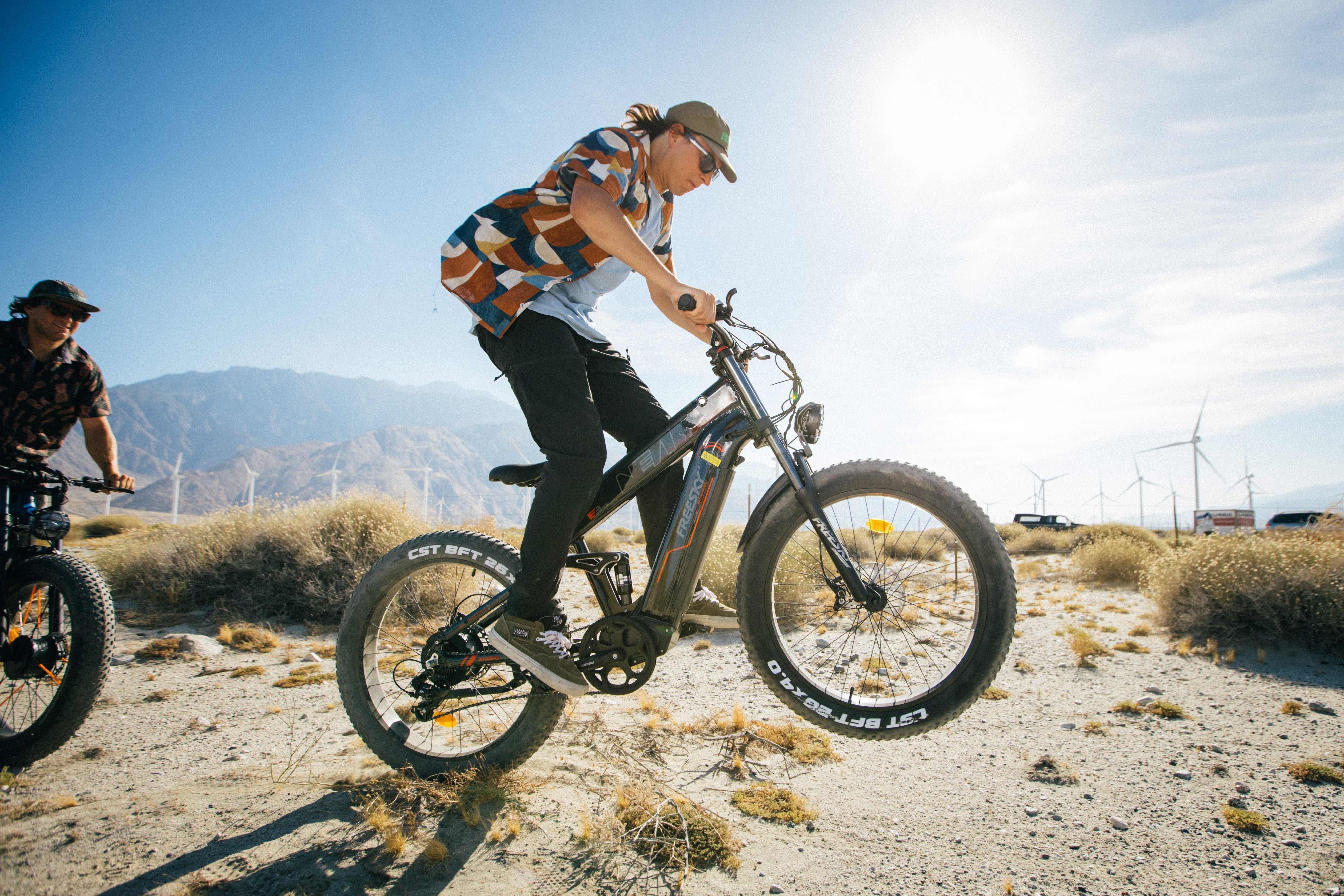
Electric Bike Revolution: Embracing the Unlimited Speed Controller
Feb 07, 2025 11:05
The electric bike (e-bike) market has witnessed exponential growth, driven by technological advancements and a push for sustainable transportation solutions. One of the most intriguing innovations in this sector is the unlimited speed controller. This component has captured the attention of enthusiasts and riders eager for an enhanced riding experience. What is an Unlimited Speed Controller? An unlimited speed controller is a sophisticated device designed to modify the speed limitations of an e-bike. Traditional e-bike controllers are programmed to cap speeds to comply with legal restrictions and safety standards. In contrast, an unlimited speed controller bypasses these restrictions, allowing riders to push their e-bikes beyond standard speed limits. Key Features: Customizable Speed Settings: Riders can adjust the maximum speed to match their preferences. Increased Power Output: Enables higher motor performance by removing speed caps. Versatility: Compatible with various e-bike models and motor types. Advantages of Unlimited Speed Controllers 1. Enhanced Performance For those seeking a high-speed thrill, an unlimited speed controller delivers a performance boost that traditional controllers cannot match. Riders can experience faster acceleration and higher top speeds, making for a more exciting and dynamic ride. Whether for daily commuting or recreational use, this enhancement opens up new possibilities for e-bike performance. 2. Tailored Riding Experience The ability to adjust speed settings allows riders to tailor their e-bike’s performance to their specific needs. From controlled, moderate speeds for casual rides to high-speed bursts for more intense adventures, the flexibility offered by unlimited speed controllers ensures a personalized riding experience. 3. Optimized Motor Efficiency These controllers can improve motor efficiency by providing more precise control over power delivery. This means better utilization of the motor's capabilities, which can translate into longer battery life and more efficient energy use during rides. Legal and Safety Considerations While the allure of unlimited speed is undeniable, it's crucial to navigate this feature with caution. Many regions have regulations governing e-bike speeds, and exceeding these limits can lead to legal consequences. Additionally, higher speeds increase the risk of accidents and injuries. Safety Tips: Protective Gear: Always wear helmets and other protective equipment to safeguard yourself at higher speeds. Local Regulations: Research and adhere to local laws regarding e-bike speed limits to avoid fines and ensure safety. Controlled Testing: If using an unlimited speed controller, test its capabilities in safe, controlled environments before venturing onto public roads. Looking Ahead: The Future of E-Bikes The unlimited speed controller is just one of many innovations shaping the future of e-bikes. As technology evolves, we can anticipate further advancements that will enhance performance, safety, and overall rider experience. Future developments may include smart controllers that adapt to environmental conditions or integrated systems that balance speed with energy efficiency. Conclusion The introduction of unlimited speed controllers marks a significant milestone in the evolution of electric bikes. While offering thrilling performance and customization options, it’s essential to approach this technology with a balanced perspective on safety and legal requirements. By responsibly embracing these innovations, riders can enjoy the full potential of their e-bikes while contributing to the ongoing advancement of electric mobility. As we ride into the future, the possibilities for e-bike technology are boundless. Embrace the excitement of enhanced performance and stay informed about the latest advancements to make the most of your electric bike journey.
Read More